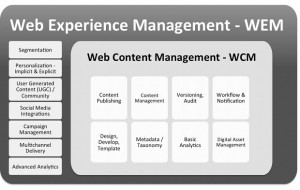How Marketing Automation can Improve Web Experience Management
 Marketing automation can improve web experience management. Web Experience Management (WEM) is focused on managing a user-friendly website by presenting a seamless contextual experience across many digital channels. Marketing automation (MA) is the process of automating manual marketing strategies to improve lead generation. Although both processes are quite different, they share the same main focus: enhancing the customer experience to build trust and loyalty.
Marketing automation can improve web experience management. Web Experience Management (WEM) is focused on managing a user-friendly website by presenting a seamless contextual experience across many digital channels. Marketing automation (MA) is the process of automating manual marketing strategies to improve lead generation. Although both processes are quite different, they share the same main focus: enhancing the customer experience to build trust and loyalty.
By integrating these two systems, marketing can gain a better understanding of customer needs and how they can effectively enhance their customer’s online experience. Powerful content can be created to address specific customer needs, new features can be added to the website to improve the customer experience, and new promotions can be offered that are based on live customer feedback.
In the same way that the combination of marketing automation and web experience management will improve the customer experience, a failure to focus on either component can have a negative effect on both. For example, it is fair to assume a customer will quickly leave a website if the site is slow or it cannot be easily navigated. This customer may have the need and the budget to make a purchase, but instead they will find a site that is easier to use and forget the original site ever existed.
Marketing automation cannot generate high-quality leads, if the site is not user-friendly. There is an endless stream of online resources, so consumers will not tolerate a site that does not meet their expectations. They will simply leave and find one that meets their needs. That is why WEM is necessary to marketing automation.
Marketing automation is used to delve into the characteristics and behavior of visitors on a given website. It creates a detailed customer profile using lead scoring and then develops relevant and informative content to nurture each lead. If a business is focused on WEM, but they are not tapping into their leads online activity, they are not giving the user an ideal online experience.
For example, a marketing firm has a home page plus seven content pages (Website Design, Printing Services, SEO, Social Media, Video Optimization, Mobile Optimization, and Advertising Campaigns). If the website consists of eight pages and only two of them are clicked on repeatedly by customers, there needs to be a greater focus on content that pertains to these two pages.
Using marketing automation, a company can pinpoint that 65% of visitors spend the majority of their time reading content on the SEO and Social Media pages, where only 5% click on the Printing Services or Advertising Campaign pages. A smart online business would then incorporate more SEO and social media topics onto their other pages and into their nurturing content.
Marketing automation can also provide insight into where a lead is at in their buying process. It is beneficial to have a WEM site that engages visitors, but there comes a time when the lead should be handed over to the sales department to seal the deal. Marketing automation ranks leads based on their likelihood of conversion and it will identify leads that are ready to buy.
When marketing automation is intertwined with web experience management there is more focus on the lifetime of interactions with a customer instead of one single transaction. This will enviably increase the chances of conversion and strengthen brand loyalty. Marketing automation improves web experience management and vice versa. It takes both to be successful in today’s competitive global market.


